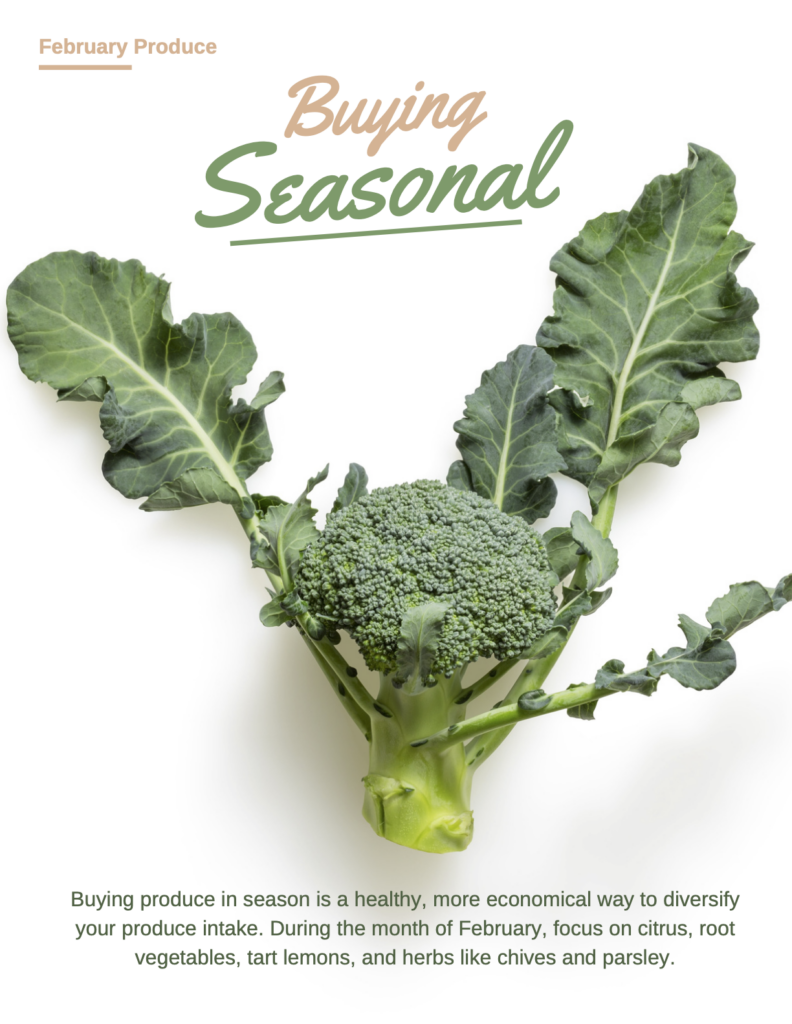This time of year, we’re conditioned to hit the ground running. We’re encouraged to create resolutions and mindfully stay the course. But remember, we’re still in the thick of winter! This is a season that—from an evolutionary standpoint—is associated with hibernation, rest, and slowness. Trust that when it’s time to spring forward, your body will let you know. Ultimately, February is all about finding roots. As we move into the shortest month of the year, focus on self-care, grounding, and nourishment. Speaking of nourishment, today we’re diving into fruits and vegetables in season in February. They’re very similar to January’s bounty. Think: grapefruit, kale, leeks, lemons, turnips, and cruciferous veg.

why you should eat more citrus
Sweet, brightly colored citrus fruits bring more than a burst of sunshine into cold, winter days. They’re packed with vitamins and minerals, boost immunity, and pair well with iron. This class of fruits includes lemons, limes, oranges and grapefruit—as well as many more hybrids and varieties. They offer a host of micronutrients, like antioxidants. And antioxidants are key for keeping inflammation at bay. Citrus also helps lower cholesterol and aid in digestion, thanks to fiber. When paired with a source of protein (Greek yogurt, cottage cheese, eggs, etc.) and a source of fat (raw walnuts, pumpkin seeds, etc.), an orange is a delicious snack to keep blood sugar balanced.

what is seasonal eating?
Consider it a sustainable way of eating—with a variety of health benefits. This lifestyle encourages you to focus on fruits and vegetables in season (for your geographic area, specifically). There are many reasons to eat with the seasons. After all, when foods are grown out of season, they can’t follow their natural growing and ripening rhythms. In order for certain fruits and vegetables to be available year-round, ripening agents are used. These include chemicals, gases, and heat processes. If you want berries in the winter, instead of opting for conventional berries (sprayed with pesticides), grab a bag of frozen organic berries instead! Mix them into yogurt, oatmeal, smoothies, or make homemade berry jam.

PRIORITIZE YOUR GUT HEALTH
As we navigate the thick of winter, there’s no better time to hone in on your gut health. After all, it leads to better digestion, balanced hormones, improved sleep, and much more. Because the bacteria in your gut influences the health of your entire body, it’s important to have a healthy microbiome. Read: a diverse microbiome. Generally speaking, an optimal gut is a diverse gut. The more species of bacteria you have, the more health rewards you reap. So, how to improve your gut health? In part, by letting this February 2024 produce guide fill your grocery basket.
EAT A DIVERSE ARRAY OF WHOLE FOODS
This includes produce rich in fiber and antioxidants. A diverse diet (ideally, with minimal sugar and industrial seed oils) can lead to a more diverse microbiome, which is beneficial for your health. When in doubt, focus on the produce section of the grocery store.
PRIORITIZE THE MEDITERRANEAN DIET
There are a variety of reasons to eat like the Mediterraneans do. But mainly because of its emphasis on vegetables, fruits, beans, and legumes. These are high-fiber, gut-friendly foods that promote the growth of beneficial bacteria. Eating a range of fresh, whole foods, mainly from plant sources, is shown to improve gut health.
CHOOSE FERMENTED FOODS
Fermented foods, like plain yogurt, kimchi, and tempeh can benefit the microbiome. They enhance its function and reduce the abundance of disease-causing bacteria in the intestines.
ADD IN PREBIOTICS
Many fruits, vegetables, and whole grains contain prebiotics, but they can also be found on their own. Resistant starch (like an unripe banana) can also be a prebiotic. If eating an unripe banana sounds unappetizing, you can also benefit from prebiotics by eating cooked and cooled potatoes and rice. The cooling process turns some of the digestible starches into resistant starches.
CONSUME PROBIOTICS
Beyond probiotic-rich foods, opt for a probiotic supplement. In essence, probiotics are often referred to as the “good”—or “helpful”—bacteria. They help keep your gut humming along. In addition to supporting digestive health, probiotics can also help with overall immune function.
LIMIT SUGAR
This is easier said than done in December, but we want to keep blood sugar balanced. After all, chronically elevated glucose levels can reduce beneficial bacteria. When it comes to baking holiday cookies and pies, consider swapping common sources of sugar for their lower-glycemic alternatives.
fruits and vegetables in season in FEBRUARY
In the spirit of keeping up with winter’s most delicious produce, here are the ingredients to focus on in February:
- Arugula
- Broccoli
- Brussels sprouts
- Cabbage
- Cauliflower
- Chives
- Collard greens
- Grapefruit
- Kale
- Leeks
- Lemons
- Mushrooms
- Oranges
- Rosemary
- Sweet potatoes
- Parsnips
- Tangelos
- Tangerines
HEALTHY Winter Meal Prep
For ideas and inspiration, look here. I have a few meal prep ideas for you! They’re healthy recipes for busy weeks.
Images courtesy of Unsplash.



Leave a Reply